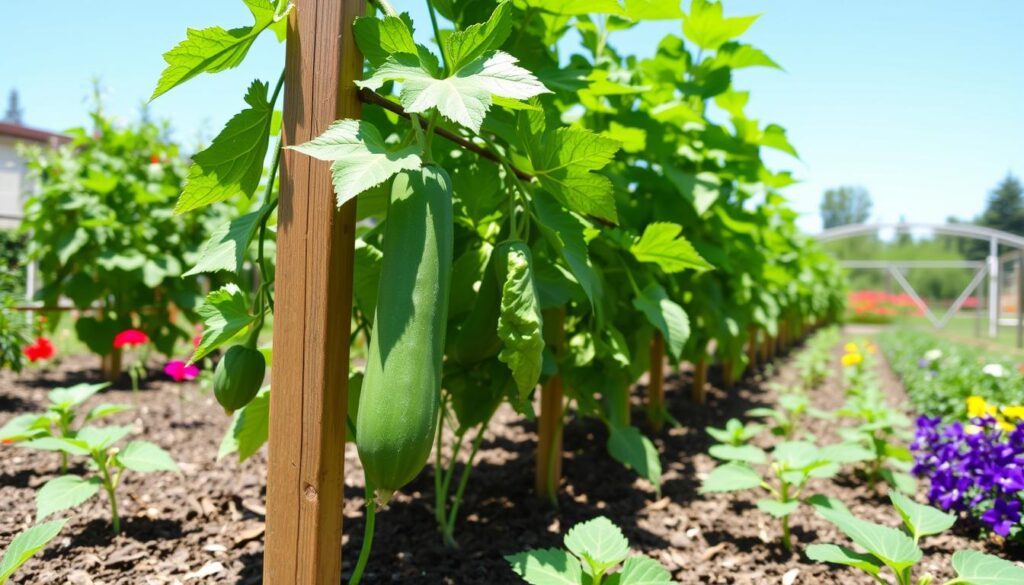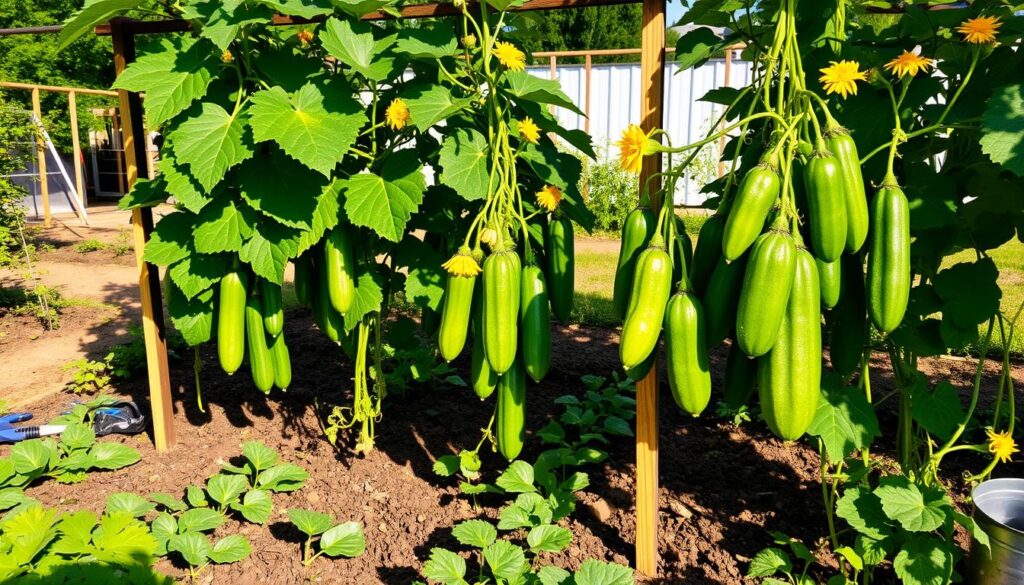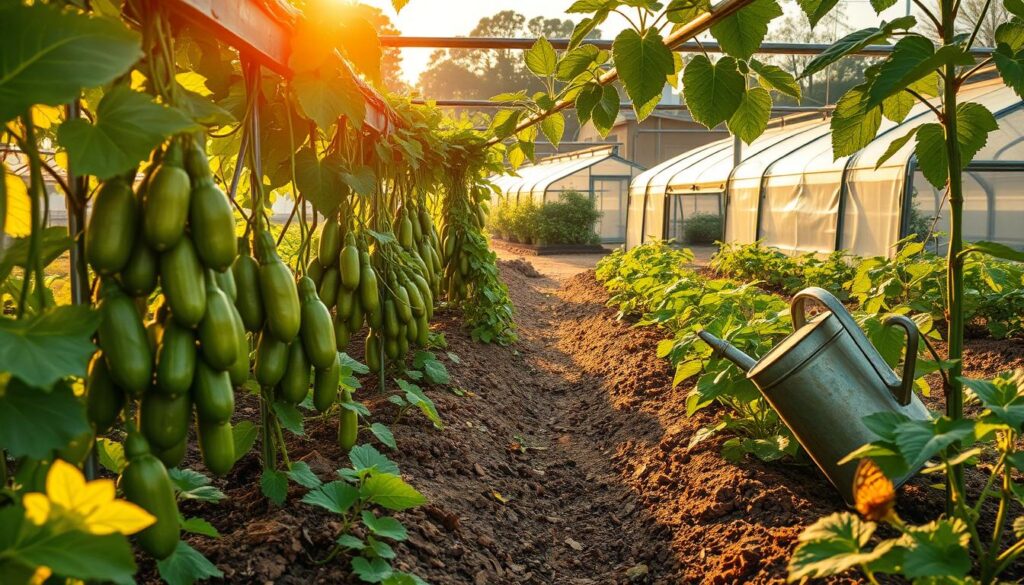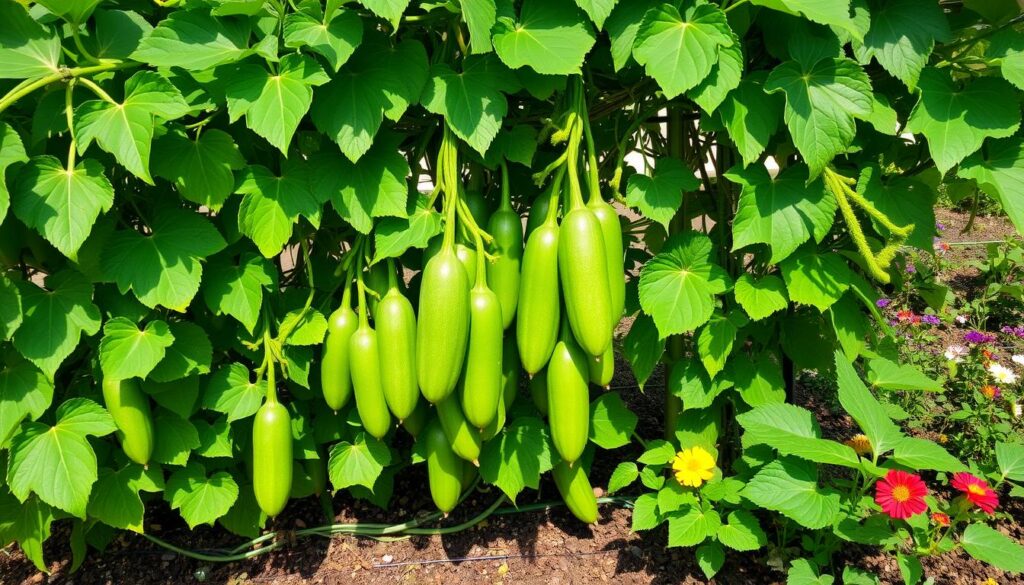Growing cucumbers can be very rewarding. With the right guidance, you can have a lot of cucumbers to enjoy. It’s important to know the basics of growing cucumbers, like the different types and what they need to grow well.
Whether you’re new to gardening or have been doing it for years, growing cucumbers is fun. With the right tools and a good spot, your cucumbers will do great. Using cucumber growing tips will help you have a healthy and big harvest.
Introduction to Cucumber Growing
Learning to grow cucumbers takes time, effort, and a desire to learn. Knowing the basics of growing cucumbers is key to a big harvest. From picking the right type to making sure they have what they need, every step is important.
Key Takeaways
- Learn how to grow cucumbers by understanding the basics of cucumber cultivation
- Follow best practices for growing cucumbers to ensure a successful harvest
- Choose the right variety of cucumber for your growing conditions
- Provide optimal growing conditions, including sunlight, water, and nutrients
- Incorporate cucumber growing tips into your gardening routine
- Be patient and dedicated to achieving a bountiful harvest
Understanding Cucumber Varieties and Their Growing Requirements
Growing cucumbers at home needs you to know about the different types and how to care for them. With the right guide, you can grow cucumbers well and get a lot of them.
There are many kinds of cucumbers, like slicing and pickling ones. There are also bush and vining types. Each type grows differently and needs different things.
Slicing Cucumbers vs. Pickling Cucumbers
Slicing cucumbers are great for salads and sandwiches. Pickling cucumbers are best for pickles. It’s important to pick the right type for what you want to make.
Bush Varieties vs. Vining Types
Bush cucumbers are small and grow fewer cucumbers. Vining cucumbers spread out and grow more. If you don’t have much space, bush cucumbers are a good choice.
Climate and Temperature Needs
Cucumbers need warm, sunny weather to grow. They do best in temperatures between 65-75°F (18-24°C). They also need enough water to grow well. By following a care guide and knowing what your cucumbers need, you can grow them successfully.
Essential Tools and Materials for Growing Cucumbers
To grow cucumbers, you need the right tools and materials. It’s important to pay attention to detail. Expert advice can really help.
You’ll need seeds, soil, containers, and trellises. These tools help create a great place for cucumbers to grow.
Choosing the right seeds is key. There are many types, like slicing, pickling, and English cucumbers. Each type has its own needs. Pick the right seeds for your space and follow the growing steps for a great harvest.
Good soil and containers are also essential. Cucumbers like soil that drains well and is full of nutrients. You can use a special mix or make your own with compost.
Containers should be big enough, at least 5-7 gallons. This gives the roots room to grow. With the right tools and advice, your cucumber garden will thrive.
Other important tools include:
- Trellises or cages to support the plants as they grow
- Watering cans or soakers to keep the soil consistently moist
- Fertilizers to provide nutrients for healthy growth
- Pruning tools to trim and train the vines
With these tools, you’re ready to grow tasty and healthy cucumbers. Follow the growing steps and get expert advice for the best results.
Selecting the Perfect Growing Location
Choosing the right spot for cucumbers is key for a great harvest. Make sure your garden or indoor area gets lots of sunlight. Cucumbers need at least 6 hours of direct sun each day.
Soil quality is also important for cucumbers. They do best in well-draining, rich soil with a pH of 6.0 to 6.8. If your soil is too heavy or sandy, add organic matter to make it better. Space considerations are also vital. Cucumbers need room to grow. Use a trellis for support and keep the area around the plants weed-free.
- Adequate sunlight and warmth
- Well-draining soil with a suitable pH
- Adequate space for the vines to spread out
- Access to water and nutrients
By following these tips, you can create the perfect spot for your cucumbers to grow well.
How to Grow Cucumbers from Seeds
Growing cucumbers at home is fun and rewarding. Starting with seeds is a great way to begin. You’ll need to choose between indoor starting or direct sowing. Growing cucumbers at home needs planning and attention. But with the right steps, you can enjoy a lot of cucumbers.
For indoor starting methods, seeds need the right conditions. Use a good seed starting mix, provide enough light and water, and keep the temperature steady. When your seedlings have 2-3 sets of leaves, it’s time to move them outside.
Optimal Planting Depths and Spacing
Plant your cucumbers at the right depth and spacing for growth. Plant seeds about 1 inch deep and 6-8 inches apart. As they grow, use a trellis for support to help them climb and produce more fruit.
By following these tips, you can learn how to grow cucumbers from seeds. Enjoy a delicious harvest. Whether you’re new to gardening or experienced, growing cucumbers at home is rewarding.
| Seed Starting Method | Direct Sowing Technique |
|---|---|
| Indoor seed starting mix | Outdoor soil with good drainage |
| Adequate light and water | Full sun and consistent moisture |
Creating the Ideal Soil Environment
To get the most out of cucumber growth, focus on a balanced soil environment. A good cucumber care guide will tell you about the importance of soil pH, nutrient levels, and drainage. The best soil pH for cucumbers is between 6.0 and 7.0. This pH helps them absorb nutrients well.
Cucumbers need a mix of nitrogen, phosphorus, and potassium to grow. A care guide suggests adding compost or well-rotted manure to enrich the soil. Also, make sure the soil drains well to avoid waterlogged conditions that can cause root rot and diseases.
Here are some tips for the perfect soil:
- Test your soil pH and adjust it if needed
- Add organic matter to boost fertility and structure
- Ensure good drainage to avoid waterlogged soil
By following these tips, you can create a great soil environment for cucumbers. This will help them grow well and increase your harvest. Always check a reliable cucumber care guide for detailed advice on soil preparation and care.
| Soil Characteristic | Ideal Range |
|---|---|
| pH | 6.0-7.0 |
| Nitrogen | 10-20 ppm |
| Phosphorus | 10-20 ppm |
| Potassium | 10-20 ppm |
Trellising and Support Systems for Healthy Growth
Growing cucumbers needs the right support for healthy growth and a good yield. Trellising and support systems are key in this process. By following expert advice, your cucumber plants will thrive.
There are many trellis options, from DIY to commercial ones. Some popular types include:
- A-frame trellises
- Obelisk trellises
- Arbor trellises
Different Trellis Options
Each trellis type has its own benefits and drawbacks. For instance, A-frame trellises are perfect for small areas. Obelisk trellises, on the other hand, are great for climbing cucumber varieties.
Installation Guidelines
To set up a trellis, place it near your cucumber plant. Gently wrap the vines around the trellis. Make sure the trellis can hold the plant and its fruit.

Training Cucumber Vines
Training cucumber vines is simple. Just guide them to the trellis and secure with twine or clips. As the plant grows, keep training the vines to climb the trellis. Make sure they’re evenly spaced and not too crowded.
By following these steps and using the right trellising, your cucumber plants will grow strong and healthy. They’ll produce a lot of fruit. Always follow expert advice for the best results.
| Trellis Type | Advantages | Disadvantages |
|---|---|---|
| A-frame trellis | Great for small spaces, easy to install | May not provide enough support for large plants |
| Obelisk trellis | Provides excellent support for climbing varieties, visually appealing | Can be more expensive than other options |
| Arbor trellis | Provides shade and support for plants, can be used for multiple plants | Can be more difficult to install, may require additional support |
Watering Techniques for Maximum Yield
Proper watering is key for a good cucumber harvest. Keeping the soil moist is important, but overwatering can harm the plants. Tips for growing cucumbers stress the need to find the right balance.
Using mulch helps keep the soil moist and cuts down on watering. It also fights off diseases and helps roots grow strong. Here are more tips for watering well:
- Water deeply and infrequently to encourage deep root growth
- Avoid getting water on the leaves to prevent fungal diseases
- Use soaker hoses or drip irrigation to deliver water directly to the roots
By following these tips, your cucumbers will get the water they need to grow well. Keep an eye on the weather and adjust your watering schedule to get the best results.
With the right watering and a bit of care, you can have a big harvest of tasty and healthy cucumbers.
| Watering Method | Benefits |
|---|---|
| Soaker Hoses | Delivers water directly to the roots, reducing evaporation and runoff |
| Drip Irrigation | Provides consistent moisture levels, promoting healthy root growth and reducing waste |
Fertilization and Nutrient Management
Growing cucumbers well means paying attention to fertilization and nutrient management. Organic farming strategies for cucumbers highlight the importance of choosing the right fertilizers. Experts agree that a balanced approach to fertilizing is key.
Deciding between organic and synthetic fertilizers is important. Organic fertilizers like compost or manure feed the soil slowly and improve its health. Synthetic fertilizers give quick nutrients but can harm the environment and soil life. Organic farming helps create a greener and more sustainable growing space.
Feeding Schedule
Having a good feeding schedule is essential for cucumbers. Start with a balanced fertilizer when planting, then use a high-phosphorus fertilizer for fruiting. Side-dressing with a high-nitrogen fertilizer helps with leaf growth and development, as experts suggest.

Signs of Nutrient Deficiency
Knowing how to spot nutrient deficiencies is key for healthy cucumbers. Look out for yellow leaves (nitrogen), purple or red leaves (phosphorus), and weak growth (potassium). Recognizing these signs helps ensure cucumbers get the nutrients they need.
| Nutrient | Deficiency Symptoms | Remedy |
|---|---|---|
| Nitrogen | Yellowing leaves, stunted growth | Apply high-nitrogen fertilizer |
| Phosphorus | Purple or red leaves, poor fruiting | Apply high-phosphorus fertilizer |
| Potassium | Weak or spindly growth, yellowing leaves | Apply high-potassium fertilizer |
Managing Pests and Diseases
When you grow cucumbers, knowing about pests and diseases is key. Healthy plants fight off these issues better. So, make sure your cucumbers get enough water, nutrients, and sunlight.
Aphids, whiteflies, and spider mites are common pests. To keep them away, try natural methods like introducing beneficial insects or using soapy water. For diseases, remove sick leaves and stems. If needed, use a fungicide.
Common Cucumber Pests
- Aphids: small, soft-bodied insects that feed on plant sap
- Whiteflies: tiny, winged insects that feed on plant sap
- Spider mites: small, spider-like insects that feed on plant sap
Disease Prevention Strategies
To stop diseases, rotate your crops and remove debris. Good air flow is also important. Row covers can keep pests away from your plants.
Natural Treatment Methods
For pests, neem oil, garlic spray, or hot pepper spray work well. For diseases, copper-based fungicides or bicarbonate solutions are good options.
| Pest/Disease | Natural Treatment Method |
|---|---|
| Aphids | Neem oil, soapy water |
| Whiteflies | Garlic spray, yellow sticky traps |
| Spider mites | Hot pepper spray, neem oil |
| Powdery mildew | Copper-based fungicides, bicarbonate solutions |
Pruning and Maintenance Tips
Pruning is key for healthy cucumber growth. Knowing when and how to prune is vital. These tips will help you get the most fruit and keep your plants looking great. Regular pruning removes weak growth, letting stronger stems thrive.
When pruning, use clean, sharp tools to avoid disease. Gardening shears or pruning knives work well. Prune in the morning when plants are full of water to reduce stress.
Here are some important tips for growing cucumbers:
- Remove lower leaves to stop fungal diseases
- Trim back vines to encourage bushy growth
- Get rid of weak stems for better growth
By following these tips, you’ll have a great harvest and beautiful plants. Always watch your plants and adjust pruning as needed.

Harvesting Your Cucumbers at Peak Ripeness
When growing cucumbers at home, it’s key to pick them at the right time. Cucumbers are ready when they’re 6 to 10 inches long, depending on the type. Check their color, size, and feel to see if they’re ready.
Identifying Ready-to-Pick Cucumbers
A ripe cucumber is dark green, firm, and has a bit of shine. Don’t pick cucumbers that are yellow or soft. They’re likely overripe. Knowing when to pick is important when learning how to grow cucumbers.
Proper Harvesting Techniques
To pick your cucumbers, cut them from the vine with scissors or a sharp knife. Leave a bit of stem on the cucumber to keep it fresh. You can also twist the cucumber gently to remove it from the vine.
Storage Methods
To keep cucumbers fresh, store them in the fridge. Wrap them in plastic or foil to keep moisture in. For longer storage, try pickling or freezing them.
- Refrigerate cucumbers at a temperature of 40°F (4°C) or below.
- Keep cucumbers away from direct sunlight and heat sources.
- Use cucumbers within a few days of harvesting for optimal flavor and texture.
Extending Your Growing Season
To extend your growing season and maximize cucumber growth, consider using row covers, cold frames, or indoor growing methods. These techniques will help protect your cucumbers from harsh weather conditions and pests. This way, you can enjoy a longer harvest.
A well-planned cucumber care guide is essential for promoting healthy growth during the off-season. This includes providing adequate light, water, and nutrients to your cucumbers. By following a detailed guide, you can ensure your cucumbers thrive.
- Use row covers to retain heat and protect your cucumbers from frost
- Utilize cold frames to extend the growing season in early spring or late fall
- Implement indoor growing methods, such as hydroponics or container gardening, for year-round cucumber production

By incorporating these techniques into your cucumber care guide, you can enjoy a longer and more bountiful cucumber harvest. Remember to monitor your cucumbers’ progress and adjust your care strategy as needed. This ensures optimal growth and productivity.
Conclusion: Growing Your Cucumber Success Story
Growing cucumbers can be a fun and rewarding hobby for gardeners of all levels. By following expert advice and using organic farming strategies, you can grow a lot of fresh cucumbers. Choose the right varieties, give them the best growing conditions, and take good care of your plants all season.
Learn how to use trellises, water, fertilize, and manage pests and diseases. This will help you become a pro at growing cucumbers. Enjoy picking cucumbers at their best and use them fresh or save them for later.
Here’s to your cucumber success story! Use what you’ve learned to grow a great cucumber patch. Impress your friends and family with your gardening skills. Happy growing!
FAQ
What are the different types of cucumbers and how do they differ in their growing requirements?
There are many types of cucumbers, like slicing and pickling ones. Slicing cucumbers are bigger and have thinner skin. Pickling cucumbers are smaller and have thicker skin.
There are also bush and vining types. Each type needs different space, support, and climate.
What are the essential tools and materials needed for growing cucumbers?
You’ll need good cucumber seeds, well-draining soil, and containers or raised beds. Trellises or support systems and gardening tools like shovels and pruning shears are also important.
Having the right tools makes growing cucumbers easier and more successful.
How do I choose the perfect location for growing cucumbers?
Look for a spot with lots of sunlight and good soil. Cucumbers need 6-8 hours of sunlight a day. They also like well-draining, nutrient-rich soil.
Make sure there’s enough space for the vines to spread out. You can use a garden bed or a trellis system.
What is the best way to grow cucumbers from seeds?
You can start seeds indoors and then move them outside, or sow them directly in the garden. If starting indoors, use seed trays or containers and give them lots of sunlight and warmth.
For direct sowing, plant seeds 1 inch deep and 12-18 inches apart. Keep the soil moist until the seeds germinate.
How do I create the ideal soil environment for growing cucumbers?
Cucumbers love well-draining, nutrient-rich soil with a pH between 6.0 and 6.8. Add compost or organic matter to improve the soil. Test the soil regularly and adjust as needed.
What are the best trellising and support systems for healthy cucumber growth?
Trellises and support systems help cucumbers grow well. They keep the vines off the ground and improve air circulation. Use vertical trellises, A-frame trellises, or cages.
Install and train the vines properly for a good harvest.
How do I properly water my cucumbers for maximum yield?
Keep the soil moist but avoid overwatering. Water cucumbers deeply, about 1-2 inches per week. Use mulch to retain moisture and prevent weeds.
What are the best fertilization and nutrient management techniques for growing cucumbers?
Cucumbers need regular fertilization. Use organic or synthetic fertilizers, following the recommended rates and schedule. Watch for signs of nutrient deficiency, like yellow leaves or stunted growth.
How do I manage pests and diseases that can affect my cucumber plants?
Common pests include cucumber beetles, aphids, and spider mites. Diseases like powdery mildew and bacterial wilt can also be a problem. Practice good garden hygiene and use row covers or traps.
Consider natural treatments like neem oil or insecticidal soap. Early detection and action are key to keeping your plants healthy.
What pruning and maintenance tips should I follow to keep my cucumber plants thriving?
Prune and maintain your cucumbers regularly. Train and trellis the vines, remove dead or damaged parts, and pinch off growing tips. This encourages lateral branching and prevents pests and diseases.
How do I know when my cucumbers are ready to harvest, and how should I store them?
Cucumbers are ready when they’re green, firm, and the right size. Slicing cucumbers are 6-8 inches long, while pickling ones are 3-5 inches. Gently twist and pull them from the vine to harvest.
Store cucumbers in the fridge for up to a week to keep them fresh and flavorful.
What are some strategies for extending my cucumber growing season?
Use row covers or cold frames to protect plants from frost. Growing cucumbers in a greenhouse or indoor setup can also extend the season. Choose early-maturing varieties and stagger your planting times for a longer harvest.
Share this post: on Twitter on Facebook

